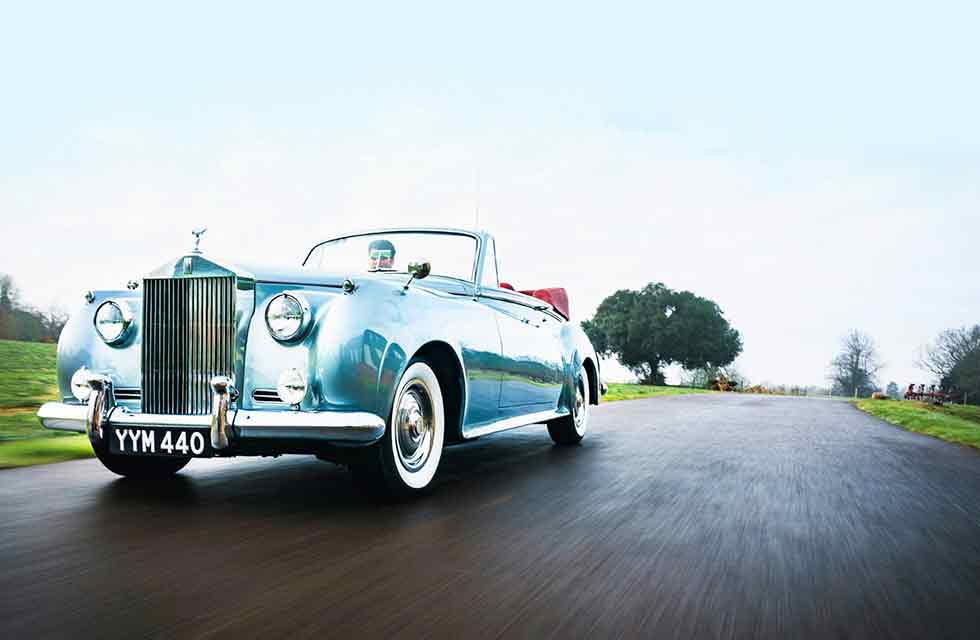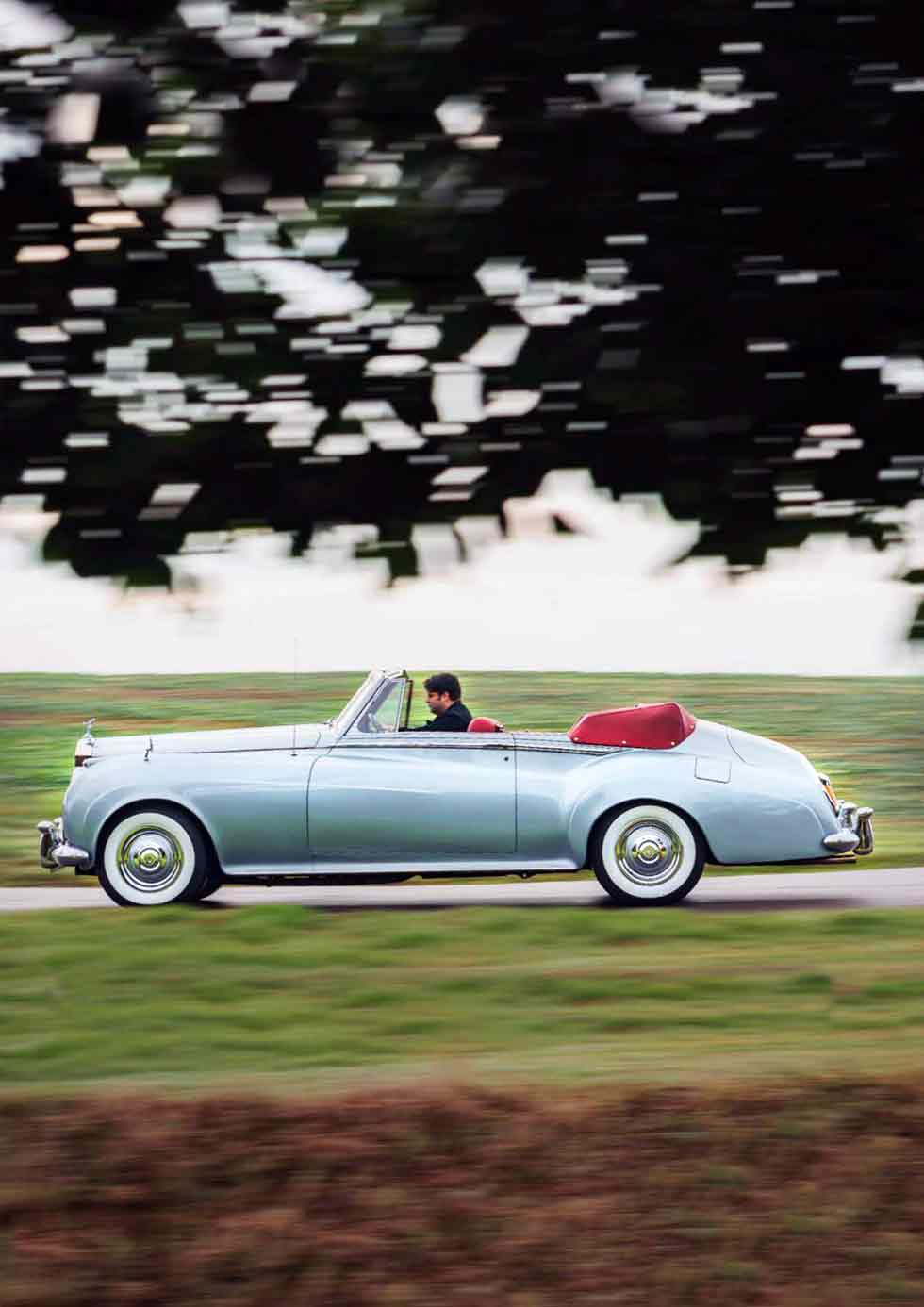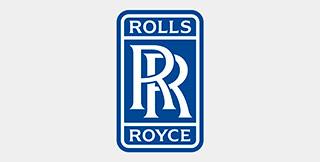
This Silver Cloud Drophead Adaptation by HJ Mulliner was a new kind of Rolls-Royce for an equally new kind of owner. We drive it, and delve into a fascinating ownership history. Words Sam Dawson. Photography Dean Smith.
CRUISE LINER Luxuriating in a tycoon s Rolls
Cruise Liner Aboard a Sixties shipping tycoon’s Rolls-Royce Silver Cloud II dhc
Postwar drophead Rolls-Royces seem to have dramatically different personalities to closed ones. A leaf through the history files of most of its older saloons will involve discreet Establishment people whose details only ever become public via the Society pages of The Times. But as soon as the roof comes off, the image changes completely to that of the celebrity, the self-made, the playboy owner-driver. The sort of potentially brash person that the Rolls-Royce might once have supplied through gritted teeth in between cars for Dukes and Maharajahs, but by the Sixties was becoming too important to ignore.

This particular car I’m gliding through the Kent countryside in, perched aloft on its soft, gently creaking leather sofa of a driver’s seat, embodies this new spirit completely in both its construction and its ownership. It’s a 1960 Silver Cloud Drophead Adaptation, a new design of open Rolls-Royce that could be built in-house using modified pressed steel saloon panels, bypassing the need to commission a separate coachbuilder. Despite Rolls’ use of the name, HJ Mulliner’s involvement was restricted to the hood mechanism and interior trim. It was still one of the most expensive cars in the world – in Rolls-Royce’s steel-bodied factory range, only the Phantom limousines were pricier – but it was more attuned to a changing market; standardised, faster to build, and in response to a buyer more likely to drive the car themselves than be driven in it. Although Rolls-Royce never stated it publicly, it was a car designed with the USA in mind, which is precisely where the majority went to the point where it’s rare to find one in right-hand drive.
‘After a decade of success, Max Wilson bought a pair of bespoke Rolls-Royces’
And it is supremely satisfying to drive. The previous driver clearly has a sense of theatre, because they’ve left the original HMV stereo tuned to Radio 3, and rather than a whirr and rumble from beyond the bulkhead, the turn of the ignition key is soundtracked by a Vivaldi chorus. I unfasten a row of chromed catches running along the header rail, press what looks like a Sixties domestic light-switch mounted by my right knee, and the fabric roof jerks abruptly backwards at surprising speed to string-section accompaniment, disappearing into a neat well behind the opulent rear seats.
‘The new Drophead was more attuned to a changing market’
Exposed to the fresh air, the 6.2-litre V8 – another innovation for the Cloud II from late 1959 onwards, replacing a straight-six with its origins in the Twenties – gives this Drophead a very different demeanour to a saloon from the driver’s perspective. Rolls-Royce used to pride itself on the ticking of the clock being louder than the engine from the silenced innards of the Silver Cloud saloon. However, lowering the roof gives the engine the rare chance to express itself to the owner. It’s still quiet, of course, but it whispers a distant, percussive shush. It’s not the motor-launch burble of a sporty Sixties GT, more like some gigantic steam locomotive resting in a siding before thundering off to some great destination-station, but with the volume turned down so the London Symphony Orchestra can take precedence.

Click the firm column-mounted gear lever into Drive, release the brake, and the locomotive chugging picks up the pace. Still whisperingly effortless, it whisks itself down these narrow lanes on a constant, but measuredly unaggressive surge of low-down torque. Automatic gearchanges are barely noticeable on the four-speed ’box, and the big windscreen and quarterlights reduce any intrusion by piercingly cold wind to a refreshing breeze, countered by forceful heater nozzles that look like a Harrier’s VTOL jets.
But this is a very different driving experience from a Silver Cloud saloon. While riding along on an aptly-named Cloud is a massively relaxing, deeply satisfying experience, all homely high-quality woodwork and deep-pile carpets of a kind you would actually appreciate in your house, removing the roof and piloting it yourself becomes an overt act of hedonism. Behind the wheel of this Drophead, you’re exposed to the elements just enough to always appreciate your surroundings, be they city or country, without being punished for it as you might in a roadster. However, also as with a roadster, you’re on show to the rest of the world, and in the Rolls’ case you’re clearly basking in a mobile luxury lounge, broadcasting wealth and self-satisfaction. It’s a feeling that only springs to mind once you acquire an audience by driving through a built-up area or in traffic, and something you’ve got to be comfortable with if you want to enjoy a car like this.
There’s something else too. Braking early to anticipate the drums’ weaknesses in coping with the two-tonne weight, I pull up at a broad T-junction alongside a Range Rover, and realise that I’m sitting level with the SUV’s occupants. In this Rolls-Royce, you can enjoy one of the boons of SUV travel – being able to see over hedges, making countryside trips a more visually rewarding experience – without compromising the car’s elegance. Given that big Rolls-Royces have always managed to carry this off, it makes me wonder what the new Cullinan SUV is for, frankly.
The reason lies in a set of proportional rules set down by designer John Blatchley, and it’s masterful. When designing a Rolls-Royce, the height of the roof should be set at exactly twice the height of the wheels. It’s a specific, waistline-slimming way of ensuring a big car never looks bulky – and the high sidewalls on the 15-inch wheels help maintain this sense of proportion too, not allowing the wheel centres to look vulgar and oversized – but as a result, this Cloud doesn’t actually look as big as it really is.
It should also look truncated – the Adaptation involved shortening the Silver Cloud saloon body and welding rear-door-derived panels onto the rear wings to form door jambs. And yet the continuation of the saloon’s waistline from the base of the windscreen, tapering to the end of the boot, ensures a flow as graceful as the car’s progress. In fact, style-wise, there’s only one aspect of the design that jars, and it’s known only to front-seat passengers – look down the nose and you’ll see the top of the radiator grille standing squarely proud of the Bentley-style soft-radius bonnet.
But this incongruous visual marker, plus the elegant teardropshaped sidelight nacelles on top of the front wings, also helps me to place this vast car on the road, by flagging up the front of that long bonnet. In turn, this gives me confidence to explore and enjoy the Cloud’s handling characteristics.
Yes – enjoy. The word ‘handling’ has managed to pick up so many connotations of sporty things performing tyre-shredding powerslides to order that it’s easy to forget how satisfying it is to pilot a car which merely keeps its considerable bulk in check through corners in the manner of this car. Turn into a bend, and although the Cloud leans, it doesn’t do so heavily, and there’s a sense of a mighty yet subtle springing force pushing gently but progressively back against all that looming weight. The springing and damping rates are just right, with no uncouth bounce on the rebound once it regains composure either.
Amazingly, there’s no Citroënesque high-tech pneumatic trickery performing all this. Front wishbones help steering precision, but it’s all old-fashioned lever-arm dampers and a rear live axle on leaf springs. In other words, essentially the same kind of layout you’d find on a contemporary Ford Zephyr, but obssessively calibrated with milimetric precision to maintain that perfect balance of confidence-inspiring control and the utmost comfort. A keen reminder that, so far as cars are concerned, the concept of a ‘thoroughbred’ extends far deeper than making your own engines. So who spent £5365 on this in 1960? As per Rolls’ fledgling owner-driver market, it was a self-made youngster by the name of Max Wilson. Whether it was a piece of canny self-mythologising – as a 1964 article in The Times hinted – or not, this South African claimed to have quit school aged 14 and run away to sea, joining the Merchant Navy, although any evidence for it other than his own word is as hard to come by now as it was 55 years ago.
Regardless of his actual origin, Wilson knew the shipping industry from the cargo deck to the bridge by his early twenties. In 1950, aged just 21, he co-formed the Overseas Visitors’ Club (OVC) with two fellow South Africans. They chartered Union Castle Line ships for Commonwealth citizens who wanted to travel to the UK from countries like South Africa, New Zealand and Australia.
The OVC based itself in the traditional bastion of Commonwealth immigration – Earls Court – and promised its clients the offer of work and a week’s accommodation, as well as the initial crossing, for £30. By 1960, its coffers swollen by people eager to start a new life in postwar Britain, the OVC owned five hotels, five restaurants, seven bars, a nightclub which helped launch Englebert Humperdinck’s career, an employment agency, an international post office, a theatre booking service, a travel agent – and a talking parrot named after Max himself.
As well as OVC headquarters, 180 Earls Court Road was also the epicentre of Max Wilson Interests Ltd. He founded what we’d now understand as a car supermarket, The Car Mart, in Middlesex – to where this car was delivered when it was completed, which must have been an incongruous sight among the Anglias and A35s. Then Wilson formed the short-lived Travel Savings Association, a forerunner to today’s budget airlines, but with his clever cost-cutting but not service-compromising approach applied to the cruise-liner industry.
When Wilson placed the order for this Cloud Drophead, in December 1959, he was just 29. And he didn’t just buy one of them, but two identical cars, complete with such special-order extras as electric hoods, front windows and radio aerials, and speakers integrated into the rear seats with their own volume controls. Total cost for this pair of excessive vehicles came to £10,750 – a sum that would have bought a Phantom limousine with change for a Rover P5, or alternatively a two-car Ferrari 250GT SWB equipe complete with transporter. The Clouds became Wilson’s London runabouts, ever-ready to impress potential business clients in a limousine role as well as his own personal transport.
But Wilson’s early success proved unrepeatable – Union Castle bought Wilson out, and TSA folded by the end of 1964. Wilson sold his shares in OVC at the same time. But he kept this Rolls as his ‘London car’, fastidiously maintaining it but not using it much, until finally parting with it in 1988.
As a 28-year-old car, it passed into even more unusual ownership. At the height of the Eighties classic-car investor boom, it was bought for £82,850 by a mysterious Hong Kong-based businessman by the name of Milan S Theodorovich. Seemingly a fashion magnate based at the epicentre of the couturier district – Ocean Centre – Theodorovich ran Metamorphosis Ltd, and based himself at one of Hong Kong’s most exclusive addresses, City Tower One – itself freshly completed in 1988.
And yet, the car still didn’t leave London, at least not yet. In a letter of 17 August 1992, Rory McGlade of classic specialist PJ Fischer entrusted with storing the car, warned Theodorovich that it was suffering because of an extreme lack of use. ‘We should regularly take the vehicle for a exercise run to keep it in good shape,’ he recommended. Theodorovich consented to runs of 50 miles every three months at a cost of £100 a trip, on top of the £100 monthly storage fee and £107 insurance bill this barely-used car was already costing him.
In 2000, Theodorovich changed his mind and had the car converted to left-hand drive, fitted with aircon and shipped to Hong Kong. It remained there until a restoration that returned the steering wheel to its original position, prior to a sale that brought it back to the UK in 2018. It still has just 30,000 miles on its odometer. It’s ready to start the next chapter of its life now. However, as I waft along beneath the boughs of broad Kentish oaks, knowing deep down that it’ll probably end up going to someone with a converted barn-based collection on the edge of the countryside, I can’t help but think it’ll be a shame that it’s unlikely to see the bustle of city life again. Because that’s where this car was born, and what fuelled its ownership into its classic years too.
Rolls-Royces might traditionally have been the car of choice for the landed gentry, but this one was created for a different kind of splendour. I can imagine Max Wilson dashing from hotel to nightclub in it, roof down with his equally young friends clustered on the back seat, music blasting out of the custom hi-fi, a dazzling flash of silver flamboyance dropping the jaws of passers-by in early- Sixties London. And it would seem just at home gliding serenely through the dazzling neon cacophony of downtown Tsim Sha Tsui and Kowloon too, an air-conditioned island of red leather serenity and high fashion amid the urban chaos. This car seems drawn to city life – it would be a shame to keep it from enjoying it once again.
Thanks to DM Historics (dmhistorics.com), where the car is for sale
TECHNICAL DATA FILE SPECIFICATIONS 1960 Rolls-Royce Silver Cloud II DHC
Engine 6230cc, 90deg V8, ohv, two SU HD6 Carburettors
Max Power 280bhp @ 4500rpm (est)
Max Torque 340lb ft @ 2500rpm (est)
Transmission GM Hydramatic four-speed automatic, rear-wheel drive
Steering Cam and roller, power-assisted
Suspension Front: independent, wishbones, radius arms, coil springs, lever-arm hydraulic dampers, antiroll bar. Rear: live axle, semi-elliptic leaf springs, radius arm, adjustable two-position lever-arm hydraulic dampers
Brakes Servo-assisted Girling drums front and rear
Weight 1930kg
Performance Top speed: 113mph;
0-60mph: 11.5sec
Fuel consumption 12mpg
Cost new £5365
Asking price £450,000
Will SUV-like lofty driving position convince this Rolls’ next owner to deploy it as a cool car about town? We can only hope…
Thanks to the special-order electrification of the hood and front windows, the Silver Cloud DHC is more practical than most convertibles of the era.
Used mainly for city lopes, the Silver Cloud has covered just over 30,000 miles to date First registered to Wilson Interests of Earls Court Road The trappings of (entirely legal) people-trafficking success.
Driver-centric ideology and softly-curved bonnet suggests Rolls-Royce was allowing some Bentley DNA seepage to attract younger new-money types.
Hand-painted burgundy coachline was specified new and renewed by Hooper via Jack Barclay in 1973.
Angular grille is at odds with the bonnet’s Bentley-like curvature.
The 6.2-litre V8 proves an excellent Vivaldi backing track.
OWNING A ROLLS-ROYCE SILVER CLOUD
Serial Rolls-Royce buyer Peter Brown has owned his Silver Cloud II saloon for four years, and uses it regularly, interchanging it with his daily-driver Peugeot. ‘Unfortunately, factory-bodied Clouds are steel, so you have to constantly budget for rust otherwise it’ll just run away from you,’ he warns. ‘I spent £600 last year, £800 this year, and just under £1k two years ago, just to keep it at bay – you can’t put filler in it! You can see orange breaking through them, not like the older aluminium-bodied cars.
‘I also like it because it’s pre-electronics, although sadly it has electric windows. There’s an awful lot to go wrong with a 50-year-old motor pulling chains, and five pages are dedicated to repairing it in the owners’ manual! ‘You have to be very careful when buying one, because according to Lord Hives it was a car “that no matter how it is abused will keep going long after any other car.” This leads to some being bodged when they need proper servicing. You don’t have to take it to a £130-an-hour specialist, but parts are unavoidably expensive – renewing the brakes last year cost £2k!’






